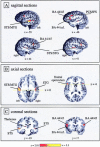Revisiting the role of Broca's area in sentence processing: syntactic integration versus syntactic working memory
- PMID: 15455462
- PMCID: PMC6871727
- DOI: 10.1002/hbm.20070
Revisiting the role of Broca's area in sentence processing: syntactic integration versus syntactic working memory
Abstract
Most previous neuroimaging studies of sentence processing have associated Broca's area with syntactic processing; however, the exact nature of the processes subserved by this brain region is yet not well understood. Although some authors suggest that Brodmann area (BA) 44 of the left inferior frontal gyrus (i.e., Broca's area) is relevant for syntactic integration processes, others claim that it is associated with working memory mechanisms relevant for language processing. To dissociate these two possible functions, the present study investigated hemodynamic responses elicited while participants processed German indirect wh-questions. Activation increases were observed in left BA 44 together with superior temporal areas and right hemispheric homologues for sentences with noncanonical word order, in which a verb argument was dislocated from its canonical position over a relatively long distance. In these sentences, syntactic working memory load was assumed to be greatest. In contrast, no activation increase was elicited by object-initial as opposed to subject-initial sentences that did not differ with respect to working memory costs but with respect to syntactic integration costs. These data strongly suggest that Broca's area plays a critical role in syntactic working memory during online sentence comprehension.
Figures



Similar articles
-
An fMRI study of canonical and noncanonical word order in German.Hum Brain Mapp. 2007 Oct;28(10):940-9. doi: 10.1002/hbm.20318. Hum Brain Mapp. 2007. PMID: 17274018 Free PMC article.
-
Neural aspects of sentence comprehension: syntactic complexity, reversibility, and reanalysis.Cereb Cortex. 2010 Aug;20(8):1853-64. doi: 10.1093/cercor/bhp249. Epub 2009 Nov 17. Cereb Cortex. 2010. PMID: 19920058 Free PMC article.
-
The emergence of the unmarked: a new perspective on the language-specific function of Broca's area.Hum Brain Mapp. 2005 Nov;26(3):178-90. doi: 10.1002/hbm.20154. Hum Brain Mapp. 2005. PMID: 15929098 Free PMC article.
-
The role of Broca's area in sentence comprehension.J Cogn Neurosci. 2011 Jul;23(7):1664-80. doi: 10.1162/jocn.2010.21530. Epub 2010 Jul 9. J Cogn Neurosci. 2011. PMID: 20617890 Review.
-
Significance of Broca's area and ventral premotor cortex for music-syntactic processing.Cortex. 2006 May;42(4):518-20. doi: 10.1016/s0010-9452(08)70390-3. Cortex. 2006. PMID: 16881262 Review.
Cited by
-
The effect of individual differences in working memory capacity on sentence comprehension: an FMRI study.Brain Topogr. 2013 Jul;26(3):458-67. doi: 10.1007/s10548-012-0264-8. Epub 2012 Nov 5. Brain Topogr. 2013. PMID: 23124385 Free PMC article.
-
Neural correlates of processing passive sentences.Brain Sci. 2013 Aug 2;3(3):1198-214. doi: 10.3390/brainsci3031198. Brain Sci. 2013. PMID: 24961525 Free PMC article.
-
Reading and Calculation Neural Systems and Their Weighted Adaptive Use for Programming Skills.Neural Plast. 2021 Aug 4;2021:5596145. doi: 10.1155/2021/5596145. eCollection 2021. Neural Plast. 2021. PMID: 34394339 Free PMC article. Review.
-
Grammatical Parallelism in Aphasia: A Lesion-Symptom Mapping Study.Neurobiol Lang (Camb). 2023 Oct 31;4(4):550-574. doi: 10.1162/nol_a_00117. eCollection 2023. Neurobiol Lang (Camb). 2023. PMID: 37946730 Free PMC article.
-
Anatomical correlates of sentence comprehension and verbal working memory in neurodegenerative disease.J Neurosci. 2007 Jun 6;27(23):6282-90. doi: 10.1523/JNEUROSCI.1331-07.2007. J Neurosci. 2007. PMID: 17554002 Free PMC article.
References
-
- Basso A, Lecours AR, Moraschini S, Vanier M ( 1985): Anatomoclinical correlations of the aphasias as defined through computerized tomography: exceptions. Brain Lang 26: 201–229. - PubMed
-
- Ben‐Shachar M, Hendler T, Kahn I, Ben‐Bashat D, Grodzinsky Y ( 2003): The neural reality of syntactic transformations: evidence from fMRI. Psychol Sci 14: 433–440. - PubMed
-
- Berndt RS, Mitchum CC, Haendiges AN ( 1996): Comprehension of reversible sentences in “agrammatism”: a meta‐analysis. Cognition 58: 289–308. - PubMed
-
- Bookheimer S ( 2002): Functional MRI of language: new approaches to understanding the cortical organization of semantic processing. Annu Rev Neurosci 25: 151–188. - PubMed
-
- Bornkessel I, Schlesewsky M, Friederici AD ( 2003): Eliciting thematic reanalysis effects: the role of syntax‐independent information during parsing. Lang Cogn Proc 18: 269–298.
Publication types
MeSH terms
LinkOut - more resources
Full Text Sources

